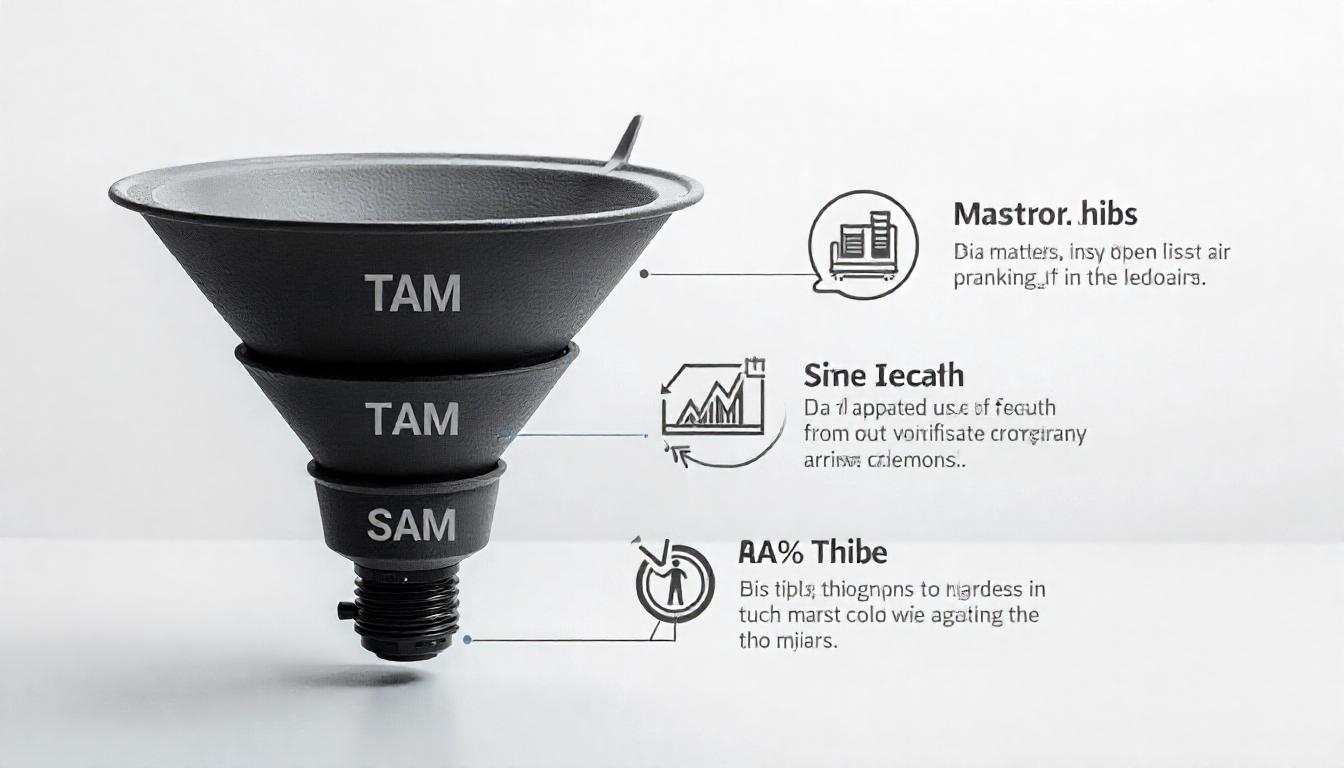TAM, SAM & SOM: What Do They Mean & How Do You Calculate Them?
When launching a business or introducing a new product, understanding your market potential is crucial. This is where TAM, SAM, and SOM come into play. These three metrics help businesses determine market size, set realistic revenue goals, and craft an effective marketing and sales strategy.
Ignoring these calculations can lead to major pitfalls. Without knowing your Total Addressable Market (TAM), you might enter an industry that’s too small to attract investors. If you don’t calculate your Serviceable Addressable Market (SAM) correctly, you may overestimate demand. Failing to identify your Serviceable Obtainable Market (SOM) could result in unrealistic revenue expectations, causing burnout among employees.
To help you avoid these mistakes, this guide will break down TAM, SAM, and SOM in simple terms and show you exactly how to calculate them for your business. Let’s dive in!
What is TAM, SAM & SOM?
1. TAM (Total Addressable Market):
TAM (Total Addressable Market) is the total demand for a product or service if there were no competitors or limitations. It represents the biggest possible revenue opportunity for a business if they could sell to every potential customer worldwide.
Example of TAM:
Imagine you are starting a business that sells organic coffee online. The total market for coffee drinkers worldwide would be your TAM. This includes everyone who drinks coffee, whether they buy organic coffee or not.
How to Calculate TAM:
There are two ways to calculate TAM:
- Top-down approach: Use industry reports or market research to estimate the total market size.
- Bottom-up approach: Multiply the number of potential customers by the average price of the product.
Example: If there are 1 billion coffee drinkers worldwide and each spends $200 per year on coffee, the TAM would be:
1,000,000,000 x $200 = $200 billion
2. SAM (Serviceable Available Market):
SAM (Serviceable Available Market) is the portion of the TAM that a business can realistically serve based on factors like location, business model, and competition.
Example of SAM:
If your business sells only organic coffee, your market is smaller than the total coffee market. You would exclude people who don’t buy organic coffee. Let’s say only 300 million people drink organic coffee. Your SAM would be:
300,000,000 x $200 = $60 billion
Why is SAM Important?
- It helps you understand your real target market.
- It ensures you focus on the right audience.
- It helps you create effective marketing strategies.
3. SOM (Serviceable Obtainable Market):
SOM (Serviceable Obtainable Market) is the realistic portion of SAM that your business can capture based on your company’s capabilities, marketing, and competition.
Example of SOM:
If your new organic coffee business can realistically capture 5% of the organic coffee market, your SOM would be:
5% of $60 billion = $3 billion
Why is SOM Important?
- It gives a realistic expectation of business growth.
- Investors use SOM to evaluate if a business can be profitable.
- It helps businesses set practical sales goals.
Why TAM, SAM & SOM Matter

TAM, SAM, and SOM are important for planning business growth. These numbers help businesses understand how big their market is at different stages. These metrics also make it easier to explain the value of a business idea. They show the size of the target audience and potential earnings in a market or niche. If a company is looking for investors, these numbers can help show business potential. They also help businesses make better decisions for future growth. For example, if a company does not clearly define its SAM, it may make its target market too large. This mistake can affect its SOM, making its goals unrealistic.
Lori Highby from Keystone Click says, “In my experience, these tools help a lot when deciding on a niche. Take the time to understand the opportunity or limitations of your target market.”
Highby explains that her team uses reports from firms like Gartner and Forrester, along with government and trade data, to calculate TAM, SAM, and SOM. This helps them find the most profitable niche.
How to Use TAM, SAM & SOM for Your Business
All this sounds useful, but how do you actually calculate TAM, SAM, and SOM? Let’s break it down into steps.
Step 1: Define Your Market
Before you can calculate these numbers, you need to know your market. Are you selling a service, a specific product, or a type of product?
To figure this out, get as detailed as possible about your audience. Consider factors like:
- Location
- Gender
- Age group
- Interests
- Problem your product or service solves
SOM is especially helpful for setting short-term business goals. It also helps businesses understand competition and plan better strategies.
Step 2: Calculate TAM (Total Addressable Market)
Now, it’s time to research. Find out how many potential customers exist and what the total market revenue would be if every customer bought your product. For example, if I am targeting women between 25 and 65, I would research how many women fit this group. Then, I would estimate the total revenue if every one of them bought my product.
Step 3: Calculate SAM (Serviceable Available Market)
Let’s say I work for a luxury women’s professional clothing brand targeting the U.S. market. I would need to find out how many women in the 25–65 age group fit my customer profile in the U.S. Next, I would calculate how much revenue could be made from this specific audience.
Step 4: Calculate SOM (Serviceable Obtainable Market)
Not every woman in this age group will shop from my brand. Women with lower incomes or those who don’t work in professional settings may not be my ideal customers.
SOM helps estimate the actual portion of SAM a business can reach. To refine this number, I would filter by income level and profession. Then, I would adjust the number further based on competition and realistic sales expectations.
Step 5: Identify Opportunities and Challenges
Once you have your calculations, it’s time to analyze the data and plan. Ask questions like:
- What is happening in the market right now?
- What are competitors doing well or poorly?
- Are there gaps in the market?
- Are there customer groups that are not being served?
TAM, SAM, and SOM Template
Now that you understand what TAM, SAM, and SOM are and their significance, let’s dive into how to calculate them. These calculations require thorough market research, but once you have the necessary data, you can use the following formulas.
1. Total Addressable Market (TAM) Calculation:
The best way to determine TAM is by performing a bottom-up analysis of an industry:
- Identify the total number of customers in the market.
- Determine the average annual revenue per customer.
- Multiply these figures.
TAM is useful for:
- Launching a new business.
- Introducing a new product, service, or category.
- Evaluating market strategies.
- Revising business plans.
- Identifying opportunities for growth.
Example TAM Calculation For high-end professional women’s apparel, the global women’s apparel market was valued at $1.002 trillion in 2023 (IMARC Group). With an estimated growth rate of 3.3% per year, the market is projected to reach $1.035 trillion in 2024.
Pro Tip: To simplify TAM calculations, tools like HubSpot’s TAM analysis template can be helpful. It also provides insights into ACV.
2. Serviceable Addressable Market (SAM) Calculation:
To calculate SAM:
- Identify potential customers that align with your business.
- Determine the average annual revenue of these customers.
- Multiply these figures.
SAM is useful for:
- Developing marketing strategies.
- Conducting competitive analysis.
- Assessing product viability.
Example SAM Calculation Using the high-end professional women’s apparel brand as an example, consider women aged 25-65. According to census data, there are 86 million women in this demographic. If each spends an average of $2,000 annually on apparel:
86 million x $2,000 = $172 billion SAM
For comparison, the U.S. women’s apparel market was estimated at $191.4 billion in 2024.
3. Serviceable Obtainable Market (SOM) Calculation:
To determine SOM:
- Divide your company’s revenue from last year by your industry’s SAM from last year to find market share.
- Multiply last year’s market share by the current year’s SAM to estimate this year’s SOM.
SOM is useful for:
- Budget planning.
- Setting realistic growth targets.
- Developing sales strategies.
Example SOM Calculation For a high-end women’s apparel brand:
- Last year’s revenue: $500 million.
- SAM in 2023: $172 billion.
- SAM in 2024: $191.4 billion.
$500 million / $172 billion = 0.003% market share 0.003% x $191.4 billion = $574.2 million SOM for 2024
Based on this estimation, the brand could anticipate 15% growth. However, external factors such as shifts in consumer spending must be considered to ensure accuracy. Regular data analysis is crucial for making informed business decisions.
Partner with our Digital Marketing Agency
Ask Engage Coders to create a comprehensive and inclusive digital marketing plan that takes your business to new heights.
Contact Us
Right Size Your Market Opportunities with TAM, SAM, and SOM
TAM, SAM, and SOM may seem like complex business terms, but they are essential for understanding market potential and making informed decisions. These figures serve as estimates to guide strategy, and their accuracy improves with thorough research and data collection.
Rather than just identifying market opportunities, research should be used to determine the target audience and the best ways to engage them. These simple formulas help in making data-driven decisions.







